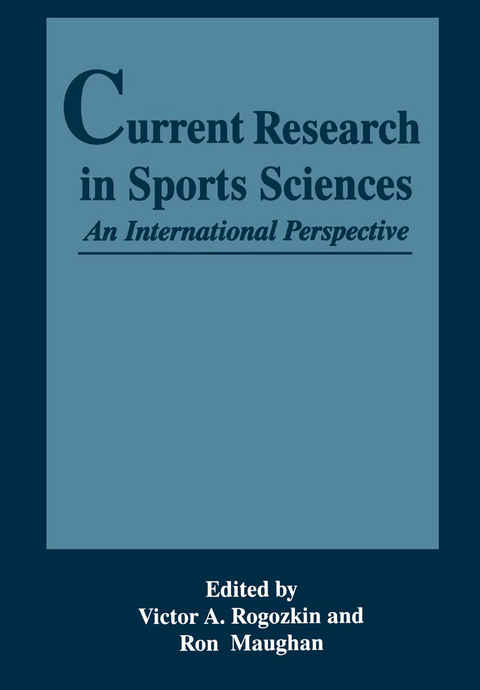
Current Research in Sports Sciences
Kluwer Academic/Plenum Publishers (Verlag)
978-0-306-45319-9 (ISBN)
1. Identification and Development of Talent in Sport.- 2. Expert Coaches’ Strategies for the Development of Expert Athletes.- 3. Selection of Children for Sports.- 4. Control of Motor Function and Its Role in Selection and Orientation of Young Sportsmen.- 5. Neurological and Pathopsychological Criteria for Sport Selection.- 6. Correlation of Physical Working-Capacity with Morphofunctional Characteristics in Boys Aged 9–15.- 7. Nutrition for Young Athletes.- 8. Fat and Fat Distribution in Elite Rhythmic Gymnasts.- 9. Body Composition and Nutritional Intake in Belgian Volleyball Players.- 10. A Computer System for Analysis and Correction of Antioxidant Intake.- 11. Mental Training for Sport and Life.- 12. Professional Sport as Sub-Culture.- 13. Psycho-Pedagogical Analysis of Individual Style of Operational Problem Solving.- 14. Prediction of the Efficiency of Skilled Athletes.- 15. Mental Relaxation — Neuro-Dynamic Markers and Psychophysiological Mechanisms.- 16. Long-Acting Regulators of Mental State in Elite Sport: Control and Optimization of Their Influence.- 17. Effects of Mental Training on Sense of Rhythm.- 18. Experience of the Application of Meditation to Shaping.- 19. Anatomical Data for Biomechanical Calculations.- 20. Mathematical Modelling of Sports Human Movements.- 21. The Control of Movement.- 22. The Application of Computer Technologies to the Management of Sport Specific Training in Rhythmic Sports.- 23. Computer Software for Canoeing Simulation: General Opportunities.- 24. Nutritional Preparation for Sports Performance: The Elite Performer.- 25. Ergogenic Effects of the Creatine Supplementation during the Training of Top-Class Athletes.- 26. Effect of Products of Enhanced Biological Value on the Performance of Athletes.- 27. The Metabolic Basis ofRowing: Variability of Energy Supply and Possibilities of Interpretation.- 28. Relationships between Fatigue and Rehabilitation.- 29. Energetic, Biomechanical, and Electromyographic Characteristics of Elite Kayakers and Canoeists.- 30. Myocardial Dystrophy in Athletes: A New Approach to an Old Problem.- 31. New Methods for the Measurement of Specific Working Capacity of Top-Level Athletes (Dynamics of Training Development).- 32. Finger Dermatoglyphs as Markers of the Functional Features.- 33. Measurement of Anaerobic Performance Characteristics of Athletes.- 34. Physical Activity, Physical Fitness, and Health.- 35. The Value of Physical Culture in a Healthy Life-Style.- 36. Physical Activity Levels of School-Aged Children in St. Petersburg.- 37. The Effects of Fitness and Quality of Health on Rating of Perceived Exertion.- 38. Influence of Ecological Conditions on the Physical Activity and Physical Status of Schoolchildren.- 39. A Screening Method for Fitness Assessment.- 40. Factors of Unfitness (Fitless Factors).- 41. Physical Fitness in Polish Children and Adolescents.- 42. Individual Approach in Exercise for Health.- 43. Comparison of Testing Methods for the Assessment of Aerobic Endurance.- 44. Effect of Exercise Training and Acute Exercise on Essential Hypertensives.- 45. Self-Resistance Gymnastics and Physical Rehabilitation of Wheelchair-Disabled in Russia.- 46. Nutrition, Moderate Exercise, and Health.- 47. Metabolic and Ventilatory Effects of Caffeine during Light Intensity Exercise in Trained and Sedentary Low Habitual Caffeine Users.- 48. Exercise Training and High Carbohydrate Diet: Effects of Vitamins C and B6.- 49. Radioisotopic Investigation of Gastric Emptying and Small Intestine Function at Different Exercise Levels.
| Erscheint lt. Verlag | 31.10.1996 |
|---|---|
| Zusatzinfo | X, 346 p. |
| Verlagsort | New York |
| Sprache | englisch |
| Maße | 178 x 254 mm |
| Themenwelt | Sachbuch/Ratgeber ► Sport |
| Medizin / Pharmazie ► Gesundheitsfachberufe ► Diätassistenz / Ernährungsberatung | |
| Studium ► 1. Studienabschnitt (Vorklinik) ► Physiologie | |
| Technik ► Lebensmitteltechnologie | |
| Weitere Fachgebiete ► Land- / Forstwirtschaft / Fischerei | |
| ISBN-10 | 0-306-45319-3 / 0306453193 |
| ISBN-13 | 978-0-306-45319-9 / 9780306453199 |
| Zustand | Neuware |
| Informationen gemäß Produktsicherheitsverordnung (GPSR) | |
| Haben Sie eine Frage zum Produkt? |
aus dem Bereich


